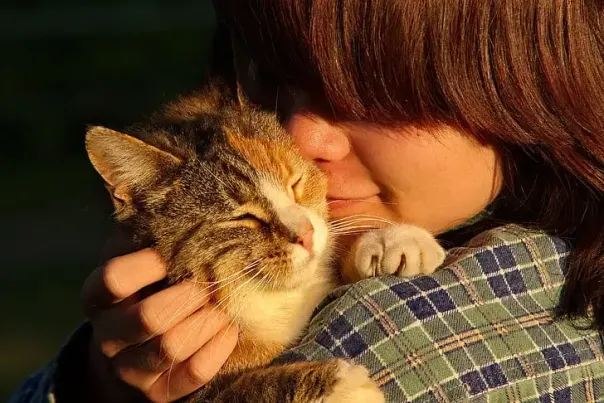How to Handle a Clingy Cat
what Is Clingy Cat Behavior?
Clingy cat behavior is a range of acts in which a cat shows too much rely on its owner. Though it may be charming, this behavior may also point to underlying problems that want attention. Understanding how to handle a clingy cat can help address these issues effectively while ensuring your feline feels secure.
Understanding Clingy Cats
Excessive Meowing
One of the most striking indicators of a clinging cat is too much meowing. Many times, this continuous vocalizing is a call to attention.
Constant Following
If your cat follow you from room to room, it may indicate insecurity or too strong attachment.
Over-Grooming
Often resulting in bald patches or irritated skin, over-grooming is a stress-related habit so a cat licks or grooms herself excessively.
Destructive Behavior
To attract attention, clinging cats might claw furniture or knock over things in damaging ways.
Common Causes of Clinginess in Cats
Early Separation
Cats taken from their moms too young may show clinging behavior because of inadequate early socialization.
Changes in Home Environment
Any changes in the surroundings of the house—such as moving to a new one or adding a new pet—may make a cat nervous and attached.
Underlying Medical Illness
Sometimes a clue of an underlying medical problem is clinginess. Rule out any health issues with a veterinarian visit.
Past Trauma Experience
Traumatic cats—those who have suffered abuse or neglect—may become dependent on their owners for protection.
Stress or Anxiety
Being sensitive animals, tension or worry may show themselves as clinging behavior in cats.
Getting bored
Lack of excitement might result in feeling bored, which drives a cat to ask their owner continuous attention.

Emotional Needs of Cats
How to Handle a Clingy Cat and Managing your cat’s clinging behavior depends on your knowing of and satisfaction of their emotional requirements. This covers love, frequent playfulness, and a safe and interesting surroundings.
For more tips on cat behavior and care, check out our other articles:
- Why Does My Cat Randomly Attack and Bite Me?
- Why Do Cats Bring You Their Kittens? Understanding Feline Love
- How to Handle Carpet Beetle Larvae Near Cat’s Food
How to Deal with a Clingy Cat
Create a Routine
Cats live for regularity. Your cat will feel less stressed and more safe if you set up a regular daily schedule.
Provide Mental Stimulation
Interactive toys, puzzle feeders, and regular play sessions can help keep your cat mentally stimulated and reduce clinginess.
Encourage Independence
Give your cat its own space that of a comfortable bed or a quiet area where they may withdraw—so encouraging their independence.
Use Positive Reinforcement
Treats and compliments will help your cat to understand that it’s OK to be alone occasionally and for independent behavior.
Create a Safe Space
Give your cat a specific safe place where they may feel calm and comfortable. This may be a cat tree with hiding places or a quiet area furnished with their preferred blanket.
Address Any Health Issues
Plan frequent veterinarian appointments to guarantee your cat is healthy. Attend to any underlying medical problems that could be causing their clinging behavior.
When to Seek Professional Help
It might be time to consult a specialist if your cat’s clinging behavior is extreme or continues despite your best efforts. Direction and encouragement might come from a veterinarian or animal behaviorist.
WHY IS MY CAT SO CLINGY? FAQ
Why is my cat following me everywhere?
For many different reasons including attention, food, or just company cats follow their owners.
Does cat clinging behavior point to a medical issue?
Sometimes clinging behavior points to a medical problem. A veterinary appointment helps one rule out medical issues.
How can I help my cat become more independent?
Provide mental stimulation, provide a secure environment, and use positive reinforcement to encourage autonomous conduct to inspire independence.
What toys are best for a clingy cat?
Interactive toys such laser pointers, puzzle feeders, and wand toys may help your cat stay interesting and lessen attachment.
Can home changes lead to cat clinging behavior?
Changes like moving, welcoming a new pet, or adding a new family member might indeed make a cat anxious and more attached.
How can I find out if my cat suffers from anxiety or stress?
Cats’ stress or worry may manifest as over-grooming, destructive activity, too frequent meowing, and clinging.
Should I ignore my clinging cat in order to discourage the behavior?
Sometimes ignoring a clinging cat helps; however, it’s crucial to strike a balance with positive reinforcement to meet their emotional needs.
Is separation anxiety the reason for cat clinging behavior?
Indeed, in cats separation anxiety may cause clinging behavior. Dealing with this calls both a regimen and mental stimulation..
How important is routine for cats?
Cats depend much on routine as it makes them feel safe and lessens anxiety and clinging.
When should I seek professional help for my clingy cat?
Your cat should consult a veterinarian or animal behaviorist if their clinging behavior is extreme, constant, or compromising of their quality of life.
External Sources and References
For more information on cat behavior and care, visit these authoritative sources:
- American Veterinary Medical Association (AVMA)
- Cornell Feline Health Center
- International Cat Care
Personal Experience
I made the mistake of lifting her up and carrying her around all the time when I first acquired my kitty. This made her rather attached. I discovered over time how to inspire her independence by arranging a comfortable bed in a quiet location and praising her for playing by herself. Though it took time, she finally became more self-assured and less dependent on me for continual attention.
Have you seen the clingy symptoms in your cat? Share your tips with us in the comments below! For more tips on kitten care, check out our other articles.

